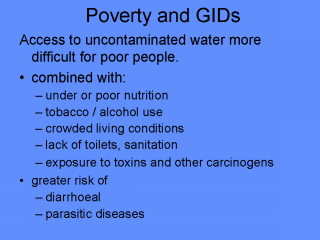 |
The link between
poverty and GIDs is well documented. Both infectious and non-infectious GIDs are more
likely to occur in poor populations than relatively wealthier ones. Lack of access to
clean drinking water is probably the most obvious contributing factor. When this is
combined with poor nutrition, tobacco and alcohol use, crowded living conditions and poor
sanitation, there is increased exposure to both toxins and infectious agents. This in turn
leads to greater risk of contracting diarrhoeal and parasitic diseases, and vulnerability
to their consequences. |
